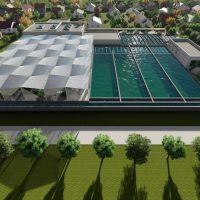How Do I Operate an Organica-Powered Facility?
- What are the operational costs?
The overall operating cost (OPEX) of an Organica FCR is significantly less than other activated sludge-based systems, primarily due to reductions in both energy demand and sludge production.Because of the solution relies on fixed-film cultures, and less on cultures suspended in the water, the water in the reactor has lower solids concentration and is “clearer”. Oxygen transfer in clearer water is more efficient, thus less air is required to be pumped into the reactor to meet oxygen demand. This results in lower power consumption, typically 20 – 50% lower than competitive designs.
Further, due to the multilevel food chains that are present in complex ecosystems, the bacteria that process waste material are consumed by other organisms, which are in turn prey for higher predators within the food chain. This food chain effect results in lower excess sludge (commonly 20 – 30% less) at the end of the treatment process.
- How energy efficient is the system?
In FCR process, the vast majority of the biomass is fixed on the natural (plant) and engineered (patented biofiber media) root structures, resulting in low suspended solids throughout each stage of the treatment process. Further, the presence of the plants helps create a loose biofilm structure, allowing oxygen to penetrate into the deepest layers of the biofilm fixed on these root structures. This combination of “cleaner” water and the loose structure results in highly efficient oxygen transfer rates, thereby lowering aeration requirements, which is the most energy-intensive part of any aerobic treatment process. The result is typically a 20-50% reduction in electricity consumption compared to other activated sludge-based solutions - Can photovoltaic panels be installed on the roof of the greenhouse?
Yes. In order to ensure natural sunlight to reach the plants it is recommended that panels are installed on no more than 25% of the total roof area. Using photovoltaic panels on the site contributes to the overall energy efficiency of the WWTP. - How much excess sludge (WAS) is produced?
The presence of plants and the cascading reactor design provides a habitat for distinctive self-regulating ecosystems, including many higher-level organisms. The resulting creation of a natural “food chain” results in up to 35% less excess sludge compared to other activated sludge-based solutions. - What is the average MLSS (mixed liquor suspended solids) concentration?
In the FCR reactors the biomass is fixed to the root structures, rather than suspended in water. We therefore use the term ‘Equivalent Biomass Concentration’ (EBC) rather than MLSS. The EBC for an Organica system is 10-18kg/m3. By comparison the MLSS in an Activated Sludge plant is 2-5 kg/m3. - How frequently do the plants need to be replaced, and how much maintenance is involved?
Such as in the nature, plants renew themselves, replacement is rarely required. The natural presence of plentiful water & nutrients provides a reliable habitat for the plants to thrive. Further, non-invasive species are utilized to minimize maintenance requiring only simple gardening skills. On average it amounts to about an hour a week for smaller facilities. All information on plant maintenance is provided by Organica in the Operation Manual. - What happens to excess plant material? How much excess plant mass is produced?
The excess plant material is put into an onsite compost bin, and the compost is used in the garden area of the treatment plant. A 10,000 PE plant requires two compost bins. - How many staff are needed to operate the plant?
Organica supplies the Instrumentation and Control Package for every Organica FCR design. This helps ensure proper operation of the facility in spite of any construction quality issues, and also gives Organica the opportunity to access data remotely and provide Process Optimization Services to the operators once the facility is operational.For process control, Organica supplies Siemens automation products with a custom library for Organica FCR designs; these tools provide the operator with an easy-to-use graphic interface.
Staffing requirements are usually determined by local regulation, taking into account health and safety factors.
- Do storm conditions affect the efficiency of the system due to ‘wash through’?
The benefit of utilizing a ‘fixed bio-film’ is protection from “wash-out” from hydraulic shock load conditions; therefore efficiency is maintained even after severe storms. - Does the Biomodule deteriorate over time?
Specifically designed to fit securely into concrete FCR reactors, the biomodule acts as the support mechanism for the biofilm carriers – both the natural (plant) and engineered (patented biofiber media) root structures – in an Organica FCR. Biomodules come pre-assembled with simple installation and operating instructions, making it easy for any EPC contractor to install them as part of the civil construction process.The Biomodules are fabricated of stainless steel to avoid corrosion; additionally the biofiber media is resistant to the conditions in the wastewater.
- What happens if a diffuser or any other mechanical equipment within the reactors requires replacement/maintenance?
Biomodules are designed for simple maintenance. The plants are not placed directly above the biofiber media, allowing visibility of the media throughout facility operation and enabling simple maintenance when equipment in the reactors (e.g. diffusers) requires replacement.After emptying the reactor, with the help of a small portable crane, the operator can pull up the biofiber media like a curtain about 2 meters high and can access the bottom of the reactor.
- How is the maintenance within the reactors affected by laws regarding confined space?
Operators carrying out maintenance within an Organica reactor would be subject to the same laws as they would be when working in reactors for other biological processes.

